The Japanese village that cooks in a hot spring
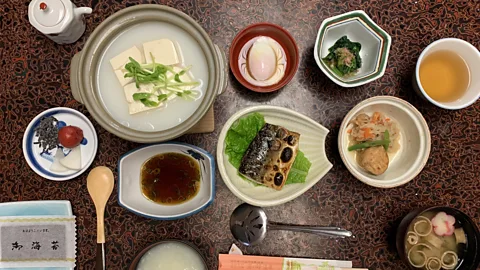 Michiyo Nakamoto
Michiyo NakamotoIn a rural village in Wakayama, Japan's only Unesco-inscribed hot spring is also where locals have been cooking their food for centuries.
On a dark and damp winter morning just before sunrise, the kitchen staff at Ryokan Adumaya, a traditional Japanese inn located in the small village of Yunomine in Wakayama prefecture, was preparing a local specialty for their guests.
In one corner of the brightly lit kitchen, Jitsuo Shinka was stirring a large pot of rice porridge, nimbly scooping it in his ladle and gently letting it spill back into the mixture. As the porridge came to a boil, a thick, slightly yellowish foam built up that threatened to spill over the rim of the metal pot.
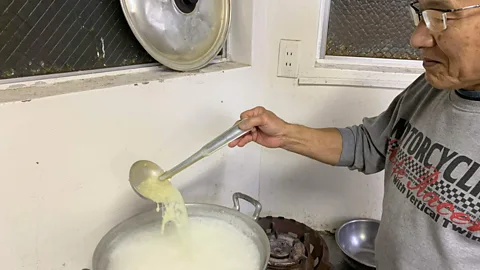 Michiyo Nakamoto
Michiyo Nakamoto“We have to let air into the porridge to keep it cool enough so that it does not boil over,” Shinka said, letting the yellow foam rise just short of the pot’s rim before stirring the mixture over and over again. “It takes about 12 to 13 minutes for the rice to cook and then it needs to steam in the pot for another 15 minutes. The foam gets thicker as it cooks and the porridge becomes stickier.” The best time to eat it, I was told, is about 15 minutes after it has been cooked.
The ryokan’s rice porridge wouldn’t require so much attention if regular water was used. But this is not your ordinary rice porridge: it is made with water from Yunomine’s ancient onsen (natural hot spring).
Of the more than 3,000 onsen bubbling throughout Japan, Yunomine’s, which was discovered roughly 1,800 years ago, is said to be the oldest. It is revered as an integral part of the sacred, Unesco-inscribed Kumano Kodo pilgrimage route that passes through Yunomine, and for centuries, pilgrims walking the 1,000-year-old trails have come to Yunomine to cleanse themselves after their long journey.
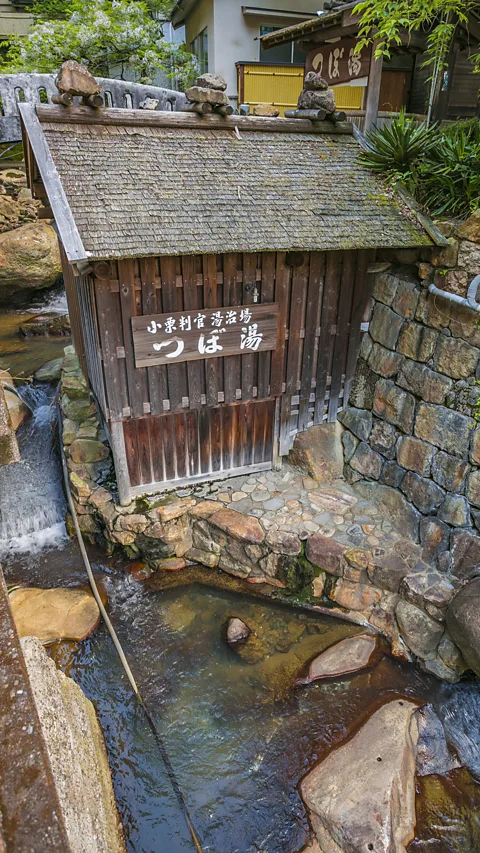 VW Pics/Contributor/Getty Images
VW Pics/Contributor/Getty ImagesTraditionally, pilgrims would soak themselves at a spot where the Yunotani River’s cool current mixes with the piping-hot, sulphur-rich waters that flow up from underground before praying at the nearby Kumano Hongu Taisha (one of the three grand shrines of Kumano). These days, this part of the Yunotani River has a covered natural-stone bathtub, known as Tsuboyu. While many of the country’s onsen are luxurious spas complete with cedarwood tubs and beautifully tiled floors, Tsuboyu is simply a rustic, one-room cabin set atop a river – but it’s renowned for being the world’s only hot-spring bath located in a World Heritage site.
You may also be interested in:
In addition to being a popular place for pilgrims to wash, the village’s hot spring has long been popular place for locals to cook. Just a few metres downriver from Tsuboyu, villagers have turned a second pool fed by the Yunotani River, known as Yuzutsu, into a kind of communal kitchen. Records show that locals have been cooking with the spring’s 90C water since at least the Edo period (1603-1868), according to Yoshiki Kobuchi at the Kumano Hongu Tourist Association.
As a result of Yunomine’s age-old onsen culture and cuisine, this tiny village has started experiencing a wave of fame.
 thanyarat07/Getty Images
thanyarat07/Getty ImagesYunomine itself is little more than a smattering of wooden houses built on the banks of the narrow, ditch-like Yunotani River. There is just one street with 26 households and a total of 50 residents. Five years ago, few foreign visitors came here. But word of the village’s unique onsen has spread, and there are now 14 guest houses and ryokans to accommodate the growing number of tourists (more than 35,000 in 2018) who come from all over the world to bathe in its medicinal waters. Ryokan Adumaya, which dates back to the Edo period, has even welcomed members of the imperial family.
Stand anywhere on the short strip along the Yunotani River between Tsuboyu and Yuzutsu and it is possible to survey most of the village. As visitors arrive, some buy eggs and vegetables at a nearby shop to join locals who cook them in Yuzutsu’s steaming-hot water, while others visit the small Toko-ji shrine in the middle of the village.
On the day I visited, sexagenarians Yoshifumi Takeshita and Takashi Nakamichi were huddled around the Yuzutsu pool, cooking potatoes in a net they had hung on one of several hooks that are placed just above the hot-spring water. The two friends are frequent visitors to the area’s hot springs but were bathing in Yunomine Onsen for the first time and were finding it particularly appealing.
 Michiyo Nakamoto
Michiyo Nakamoto“This place is very secluded, like a hidden onsen. There are no new buildings, so it’s very atmospheric,” said Takeshita.
Later that day, Hiroko Kikuchi, Yoshiko Wada and Takeko Kuraya, three members of the village’s association of ryokan and guest-house owners, gathered around Yuzutsu to show me what wonders cooking in onsen water can do to fresh vegetables.
“See how beautiful this green colour is?” said Kuraya, giving me a piece of broccoli she had boiled in Yuzutsu. Even in the dim light of the street lamp at night, the bright-green hue was clear to see. “Cooking in onsen water takes the bitterness out of vegetables,” Kikuchi added.
When I bit into the crunchy floret, I was surprised to find that it tasted slightly sweet, with no hint of the strong sulphuric smell usually associated with hot-spring water. Using onsen water makes everything taste milder, explained Wada. In addition to vegetables and eggs, tofu cooked in onsen water is another local favourite.
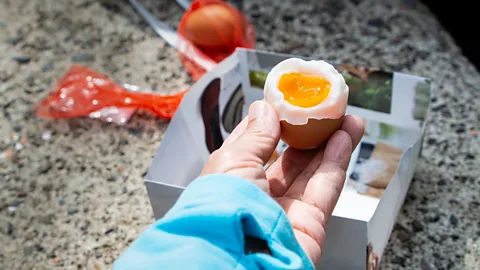 Janice Chen/Getty Images
Janice Chen/Getty Images“We also drink the onsen water every morning, because it is said to be good for the stomach,” said Kuraya. All three women encouraged me to try coffee made with onsen water.
These days, it’s increasingly rare for local residents to cook in Yuzutsu, since hot-spring water is piped directly into their homes. Yet, everyone goes there to cook takenoko (bamboo shoots) when they are in season, said Yosuke Tamaki, proprietor of Ryokan Adumaya.
“It’s called the takenoko traffic jam,” he said, smiling.
In spring, locals will dig for bamboo shoots, soak them in Yuzutsu and head off to work. When they return in the evening, the bamboo will be cooked and the bitterness of raw bamboo shoots will have vanished.
It was not bamboo shoot season at the time of my visit, but later that evening, I settled down to a sumptuous dinner at Ryokan Adumaya, where I was served several dishes prepared with onsen water. Truth be told, I could only detect a slight difference in their texture and flavour.
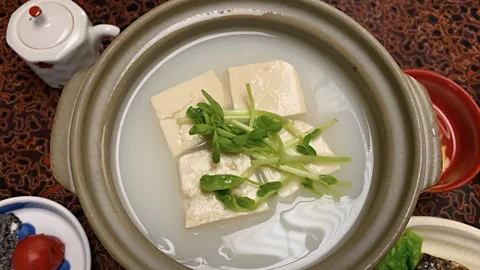 Michiyo Nakamoto
Michiyo NakamotoHowever, the onsen-cooked steamed kabocha (pumpkin potage soup) had a pungency that is not normally associated with the vegetable and tasted less sweet than most kabocha. The beef shabu-shabu hot pot made using onsen water tasted slightly more minerally – though not sulphuric – than ordinary shabu-shabu. And while the onsen-steamed rice retained the same flavour as normal short-grain rice, it was noticeably stickier.
According to local residents, cooking with onsen water does not radically alter the taste of food, but it does make it milder in flavour. Unlike regular tap water, it also has the benefit of keeping meat tender, even if you cook it for a long time.
Yunomine’s onsen water happens to have the right balance of minerals for cooking, explained Tamaki. If there is too much iron or sulphur, it would be impossible to cook with it, much less drink it, as locals do.
The next morning, I was treated to one of the highlights of my visit: tasting the rice porridge I had witnessed being prepared in onsen water in the Adumaya kitchen. It was very sticky and yellow and – in contrast to the dishes served for dinner – it had a distinct, though not overpowering, sulphuric smell. It took a bit of getting used to, but after a few mouthfuls, I was hooked. Plain porridge is not something I would normally relish, but I found onsen porridge tasty enough to enjoy on its own.
 Michiyo Nakamoto
Michiyo NakamotoHowever, it was the onsen coffee, which the inn owners had encouraged me to try, that was the biggest treat of all. It was mild and flavourful and possibly the best coffee I have ever had – so good, in fact, that I did not want to dilute its flavour by adding milk. I normally drink just one cup of coffee in the morning, but I easily finished the first pot they brought me and could not resist asking for another one.
In addition to possibly being the oldest onsen in Japan, Tsuboyu may be one of the smallest, too. The tiny hut sits directly above the river and can accommodate just two to three people at a time. Because of its popularity, there’s often a snaking queue outside the wooden cabin, and after taking a ticket, bathers are only allowed to sit in its soothing waters (which are said to change colour seven times each day) for 20 minutes.
There may be more tourists than pilgrims passing through Yunomine these days, but whether through cleansing or cooking, Tamaki said that people are now coming to this tiny village to consume its onsen “from within and without”.
Join more than three million BBC Travel fans by liking us on Facebook, or follow us on Twitter and Instagram.
If you liked this story, sign up for the weekly bbc.com features newsletter called "The Essential List". A handpicked selection of stories from BBC Future, Culture, Worklife and Travel, delivered to your inbox every Friday.
{"image":{"pid":""}}
